Mitchell – Foster – Young House
|
Mitchell – Foster – Young House | |
  | |
| Nearest city | Oxford, Mississippi |
|---|---|
| Coordinates | 34°23′28″N 89°23′39″W / 34.391039°N 89.394229°WCoordinates: 34°23′28″N 89°23′39″W / 34.391039°N 89.394229°W |
| Area | less than one acre |
| Built | c1840 |
| Architectural style | Center-hall cottage |
| NRHP reference # | 07001182[1] |
| Added to NRHP | November 14, 2007 |
The Mitchell – Foster – Young House is a historic house located just outside Oxford, Mississippi off the highway to New Albany. The house, thought to be one of the oldest standing farmhouses in the county, is listed on the National Register of Historic Places.
Background
Beginning when the original 1839 land grant was issued, the property was an active working farm until mid-1942 when then owner George W. Young became infirmed and left to live with relatives in central Mississippi. After he vacated the house, it was then rented for several years. It subsequently was closed and remained unoccupied for over six decades.
Over time, weather and decay caused all out buildings, including the barn, to fall but the house remained primarily due to the integrity of the corrugated metal roof. The house's isolation in the woods hid and protected it from potential vandals.
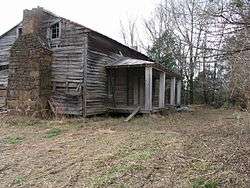
Rotting at the corners where vines and moisture encroached finally undermined the integrity of the structure and the unoccupied house was in danger of collapsing in 2005, when a plan to repair it was created. Those plans were abandoned when termite and other animal-caused damage was discovered. The house had been originally built too close to the ground, making it impossible to avoid future similar damage if the house was simply repaired without a proper higher foundation. Alternatively, a plan was implemented to completely restore the house by dismantling it nail-by-nail and board-by-board. A newly built barn housed the methodically marked and cataloged timbers and boards, until a new, raised foundation was built. Then, in reverse order, the timbers and boards were reinstalled.
Several unanticipated and yet to be explained building techniques and materials used in the house's original construction were discovered during the restoration process. Additionally, a detailed review and assessment of each prior owner was performed using property and US Census records. Collectively, they established more clearly the phases and dates of construction.
History
Several years after the Treaty of Pontotoc Creek between the Chickasaw Nation and the government was signed in October 1832, land grants were sold. The treaty ceded land that is now north Mississippi and western Tennessee. In Lafayette County, created in 1836, the more popular land grants were near the rivers west of the town of Oxford. The land to the east was hillier and relatively less desirable.
In 1839, the US government granted the Mitchell – Foster – Young property, east of the town of Oxford, to a gentleman who apparently did not live on the property, but did live in Lafayette County. He applied for and received a brand from the newly formed county and used the property for his cattle that roamed freely. He likely built the original 20' x 20' log cabin c1840 for his overseers.[2]
The original owner sold the property in 1847[3] to a farming family of six that lived in the Paris community of Lafayette County. They were responsible for renovating the one room log cabin, converting it to a three-room house with a gable roof. It took them several years to construct the addition to the house. In the 1860 US Census,[4] they were still living in the Paris community. They likely completed the house and moved before the outbreak of the Civil War. By the time of the 1870 US Census,[5] they are living in the house.
This large farming family owned the house until 1894.[6] During the time they owned the property and lived in the house, it is likely the final construction was completed.
George W. Young's father-in-law bought the property in 1900 and died shortly thereafter. George and his family moved onto the property and he farmed the property until 1942.
Description
The Mitchell – Foster – Young House is located east of Oxford, Mississippi.[7] The house is a two story, side-gabled, center-hall planter's cottage with a rear ell.
The original c1840 cabin was a one-room structure with the massive stone fireplace, a gable roof, no windows, and a door facing the north.
The house was augmented in at least three phases and is believed to have taken its present form c1859.
The main façade facing north is three bays wide (room 1, foyer hall and room 2) featuring double four-paneled door entrance in the central bay, flanked by a pair of six-over-nine, double-hung "cottage" windows in the outer bays. An undercut gallery with plain square wood posts spans four-fifths of the façade and features a wooden deck and boxed columns.
The west façade is also three bays wide (room 2, room 3 and room 4) featuring a brick shouldered chimney in room 2 flanked by a pair of four-over-four windows on the main floor and a pair of two-over-three windows in the second floor attic, a pair of six-over-six windows in room3 and an exit door in room 4.
The rear of the house facing south is three bays wide (room 4, center hall and room 1). There are no windows at the end of ell but there is a six-over-nine window on the rear of room 1. The rear has a single exterior door from the hall.
The east façade is also three bays wide (room 4 and room 3 in the ell, and room 1) featuring a small two-over-two window in room 4, a single exterior door from room 3 and a sandstone shouldered chimney on room 1 flanked by a pair of two-over-three windows in the second floor attic.
The house rests on stone piers and the roof is clad in corrugated metal. The walls of the main façade are clad in weatherboard siding.
Construction Phases
Constructed c1840, the house was originally a single 20' x 20' room (room 1) with a massive fireplace on the east wall.
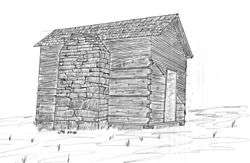
The cabin was constructed with large hand-hewn heart of pine timbers. Using a broad axe, the timbers were hewn flat on both the exterior and the interior sides. The rectangular hewn timbers were typically in excess of seventeen-inches high and six-inches deep. They were stacked horizontally from just above the ground to a height of approximately 12 feet at the eve of the gabled roof, which ran north to south. On the east side, the eve was just below the top of the chimney. The timbers, some eighteen feet long, were joined at the corners with square notching. The sill timbers were supported at the corners with piers composed of stacked local rocks.
There were generally two reasons that builders of the period hewed the exterior and/or the interior of the timbers into a flat surface. One reason was to remove the bark and sapwood layers which, over time, promoted rotting, and the second reason was to apply weatherboard siding on the exterior or wall boards on the interior. The cabin likely had both interior wall boards and exterior weather strip siding.
The interior ceiling in the cabin was eight feet high and the ceiling rafters were notched into the fourth from the top course of timbers, leaving about four feet of attic space at the eves, and approximately seven feet at the gable ridge. With a hole in the ceiling and a wall mounted ladder, occupants of the cabin likely used the space for sleeping and storage.
The fireplace chimney on the exterior of the east wall extends to the original height of room 1 and is constructed from large blocks of local sandstone.
The house was augmented with phase 2 c1859 with the center foyer hall, and the second room (room 2, the right front façade bay), a small front gallery, and a second story attic accessible by stairs in the hall.
In phase 3, a third room, room 3, built c1870 directly behind the room 2, was constructed on a beam base using 2" x 4" wall studs spaced irregularly. Room 3 measures 15' 4" x 14' 0". The interior wall of room 3 facing room 2 has the exterior weatherboard of room 2. Room 3 was built abutted to but not structurally integrated into the main house except with the roofing.
The 9' 6" x 13' 6" room, room 4, was built behind room 3 at the same time, and is also built on a beam base using 2" x 4" studs spaced irregularly. Room 4, used as a kitchen, has an insulated chimney sleeve for a stovepipe.
The original kitchen was built probably during phase 2 and detached from the house to isolate accidental fires. The vertical pine timber materials used in room 4 are similar to those used in room 2. The interior wallboard materials in room 4 are believed to be the wood that was used for the original detached kitchen when it was built during phase 2. The interior boards have square nail holes, indicating that they had been used prior to phase 3. In phase 3, the kitchen was attached to the house.
Since the completion of phase 3 c1870, no significant alterations have been made to the house. [8]
Construction Techniques
Phase 1: c1840 Log Cabin
The c1840 log cabin was built from pine logs laid horizontally and interlocked with notches on the ends. The old-growth trees used had few limbs (knots) and were straight with little taper. The corner notches were not uniformly cut, indicating that each log's corner notch was cut to match the specific cut of the adjoining log to minimize the size of the gap between the logs and reduced the amount of chinking (sticks or rocks) or daubing (mud) needed to fill the gap. The length of the available logs determined the length of each wall.
The cabin's corners were set on large stones and additional stones were used for support at other points along the sill (bottom log).
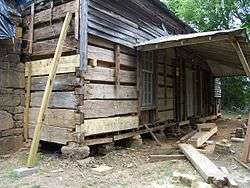
The cabin was anchored on a fieldstone chimney; with mud applied to seal any gaps in the tight fitting stones. The fireplace was used for cooking and for heat in the winter.
The cabin roof was gabled. There is no evidence that there were windows. Specifically the west wall was composed of single timbers. The entrance door was to the north; where a window is installed today.
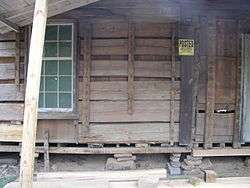
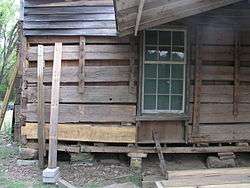
Phase 2: c1850 Addition
The second owner, who ultimately lived on the property, bought it in 1847 and held it for forty-seven years until 1894. Most of the phase 2 and subsequent construction probably occurred during this period. During this timeframe, balloon framing was a popular and inexpensive technique for many farm houses in the 19th century. Requiring no specialized skills, it utilized long continuous framing members (studs) that ran from sill plate to eave line with intermediate floor structures nailed to them, with the heights of window sills, headers and next floor height marked out on the studs.
Surprisingly, balloon framing was not used on the c1850 addition, but rather a more complex method of mortise and tenon joinery that typically requires highly skilled workmen.
The foyer, room 2, gable roof, and the attic were built to the right of room 1. The room 1 ceiling was lowered to the current height of 8 feet.
Framing - The vertical posts on the north and south side for room 2 and the foyer, built on an irregular beam base, were extended in length above the interior room ceiling to the top attic rail. The length was designed to match the height of the original room 1 roof. The vertical posts were long enough to extend about four feet above the ceiling joists.
A top rail across the front (north side) of room 2 and the foyer and another across the rear (south side) of room 2 and the foyer tied the vertical beams all together. Each vertical post had a hand-made mortise at interior ceiling height to receive each ceiling joist, which had a tenon at each end. A wood peg secured each joint. The peg holes were chisel-cut with a square hole by hand, as opposed to round holes made with a drill, indicating construction in early 1800's. The pegs were hand-formed with an ax from small cut blocks of wood and sized to each hole. Additionally, vertical water saw marks marking are on the vertical posts. Neither the room 2 nor the foyer framing used nails.
During the restoration, the removed interior walls revealed that one of the vertical posts was larger than others and had an unused mortise. This indicated that it had been recovered from an older derelict building and was likely brought to and adapted for the construction site.
Interior Finishing - The foyer and room 2 had interior wall, floor, and ceiling boards installed. Included also at this time was a wainscot in the foyer and room 2. Room 1 also had interior wall and ceiling boards installed for the first time.
Exterior Openings - The exterior doors into the house, a double door in the front and single door in the back, were now through the foyer. The original room 1 door facing the north was closed in and replaced by a window identical to the one used in the new room 2 windows. An interior door was cut through the massive beams in the west wall of room 1 for passage into the foyer.
Windows - There may have been glass windows installed for the first time with phase 2. Alternatively, wooden shutters closed in the evenings would have been used. Around 1935 the current glass single pane windows were installed, replacing the prior windows or alternatively replacing the shutters.
Ceiling Height - The room 1 ceiling was lowered from its original height to its current height. Notched top rails in the attic, approximately four feet above the ceiling floor, indicate both the height of the original ceiling joists and the slope of the flat roof. West Chimney - A brick fireplace and chimney was installed on the west end of room 2. The fireplace chimney in room 1 was extended in height to accommodate the gable roof height with brick similar to that used in the fireplace in the room 2.
Roof - The complete building (room 1, foyer, and room 2) was covered by a gable roof that ran east/west. The roof was covered with cedar shakes. The shake roof was later replaced by corrugated metal.
Attic - The gabled roof facilitated an attic. The current stairs were not installed until later, so access to the attic would have been in the foyer, perhaps with a ladder. Also some attic flooring was added. The space was there, and probably badly needed and yet accessible only with a ladder.
Porch - A small undercut gallery with plain square wood posts spans the width of the double front door and featured a wooden deck and a side rail. It may or may not have had a cover. This small porch was later replaced by the current large gallery porch.
Exterior Finishing - The entire house was covered with cedar weatherboard. At the front eave an intricate molding was installed. Similarly across the rear a decorative molding was installed.
Kitchen - The outdoor kitchen was probably built at the same time. Timbers similar to those used for the interior walls of room 1 and room 2 were used in the standalone kitchen.
Large gallery porch - A larger undercut gallery with plain square wood posts spanning four-fifths of the façade and featuring a wooden deck and box columns replaced the original. Two exterior boards on either side of the front door have the mortise holes for the top and bottom porch rail. [9]
Restoration
The restoration of the c1840 house was completed in 2012.
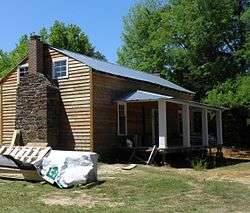
References
- ↑ National Park Service (2010-07-09). "National Register Information System". National Register of Historic Places. National Park Service.
- ↑ John Cooper Hathorn, Early Settlers of Lafayette County Mississippi, Skipwith Historical and Genealogical Society, Inc, 1980.
- ↑ Lafayette County Book of Deeds
- ↑ US Census 1860 - Lafayette County, Paris, M653 Roll 585 Page 173
- ↑ US Census 1870 – Lafayette County, Beat 1, M593, Roll 743 Page 498a, Part of Township 8, page 32
- ↑ Lafayette County Book of Deeds
- ↑ Lafayette County: "Tax Records", 2007.
- ↑ Boyd, Charles P.: "NRHP Application", 2007.
- ↑ Boyd, Charles P.: "George Wright Young House, Lafayette County, Mississippi", Atlanta, Georgia, 2012.